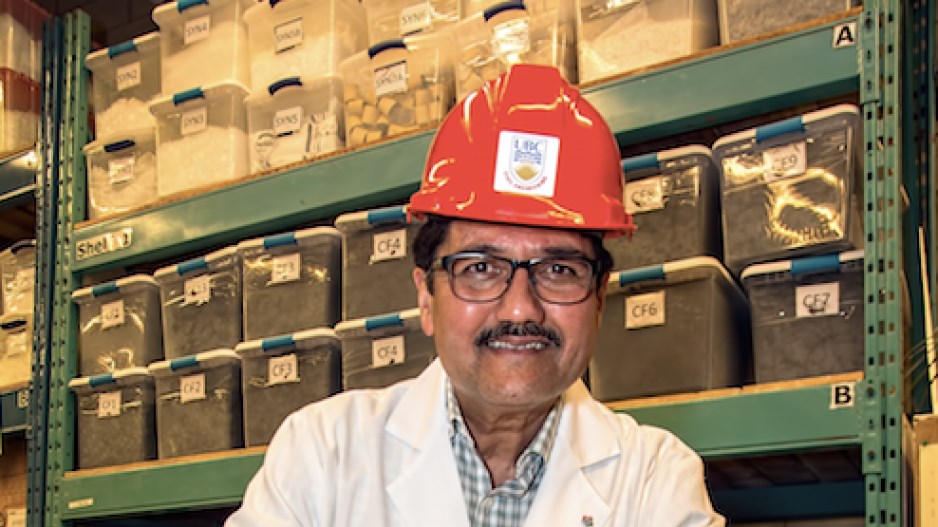What began with a small stretch of road in the rural Indian village of Thondebhavi five years ago could soon become the next big thing in global road transportation infrastructure.
That’s the potential of the pavement material pioneered by Canada-India Research Centre of Excellence IC-Impacts – based on the University of British Columbia (UBC) campus and headed by civil engineering professor Nemy Banthia. The product is now licensed to a consortium in India and being produced to aid New Delhi in its quest to completely modernize its infrastructure throughout the world’s second most populous country.
Banthia – also the CEO and scientific director at IC-Impacts – returned from India earlier this year to meet with a number of stakeholders, and he noted that the innovative pavement material is now scheduled to be used for two separate 10-kilometre road projects, one in the central state of Madhya Pradesh, the other in the southwestern state of Karnataka. The projects are scheduled to be completed by the summer.
“We hope this will really change the infrastructure scene in India,” Banthia said. “Basically, India needs about three million kilometres of road, and with this new government, they are very excited about things made in India, and this fibre is now made in India. We hope that, very soon, we will see a lot more projects that will be done with this technology.”
IC-Impacts, formed in 2013, is a research initiative co-funded by Ottawa and New Delhi. After 38 successful research projects and 16 technology deployments from those projects – including the showcase road in Thondebhavi – both governments extended funding to the program in 2017 by $8.4 million each, allowing the initiative to carry on through 2021.
What makes the pavement material so attractive in markets like India and rural Canada, researchers say, is the unique inclusion of fibres that allow for the pavement to be very thin, which reduces its cost compared with conventional concrete. The material also lasts longer. Banthia said the Thondebhavi road has gone through five South Asian monsoon seasons with flying colours. Sixty per cent of the pavement’s material is made from ash that is a byproduct of local thermal power plants.
Therefore, as Banthia noted, the material makes sense functionally and financially, but it also contributes to local sustainability efforts.
Even then, he said, it took five years for the Indian market to fully trust the technology. That breakthrough has now been reached with the announcement of the two 10-kilometre road projects this summer.
“This is not like IT, which changes very rapidly,” Banthia said.
“Safety is of paramount importance, and these [infrastructure] industries don’t change as rapidly, and we always struggle with being ahead and trying to convince industry to trust us with these new materials. Industry tends to be conservative.
“This is why demonstration projects are so important. A demonstration project does two things: it creates the confidence in technology because people see it in service, but it also creates confidence in the people who are bringing the technology, because you are now sure that, whatever guarantees are there with a product, you can now put trust to the people behind the product as well.”
Efforts to test the material’s effectiveness in Canada are now also underway. A newer version of the pavement material – with an added element of cold-weather resistance, as well as an advanced self-repairing capability due to the use of cellulose fibres – was installed at a parking lot in Chawathil First Nation near Hope last summer.
The newer material also employs IC-Impacts’ sustainability focus in the Thondebhavi project by using scrap tire fibres to improve its durability. That’s important, Banthia said, because there are more than four billion tires made every year – and fewer than 10% are currently recycled.
The 26-by-18-metre lot is being monitored by UBC researchers associated with IC-Impacts to see how it holds up in the next year, but Banthia said he is already very excited at the potential of this material given its track record in India.
The most exciting prospect, he said, is beyond just pavements. Because the material is essentially fibre-enforced concrete, its application in everything from dams and bridges to office buildings and public facilities is almost limitless.
Given the material’s low carbon footprint, lower maintenance costs and high sustainability, all it needs is for industry to see its effectiveness first-hand.
“The infrastructure market out there is close to $200 billion a year,” Banthia said.
“And each one of those projects can replace their conventional materials with this self-healing material. So I think that’s the magnitude we are talking about. We are only scratching the surface, slowly but surely; this is a platform technology and material, and it doesn’t just apply to roads or dams or buildings. It can be applied to almost everything.”
He added that – given the fact that this is a Canadian technology – the potential is also there for Canada to flex its global muscles as a technological and engineering powerhouse if the new material can gain traction globally.
One needs to look no further than Thondebhavi for evidence, he noted.
“If you ever get a chance to go to India, please go to this small village,” Banthia said.
“The moment you say you are from Canada, the residents will thank you for building the road there. It’s not a charity; we are demonstrating a technology … and when a small village sees a state building technology that is improving their daily lives, that does a lot for our international prestige.” •




